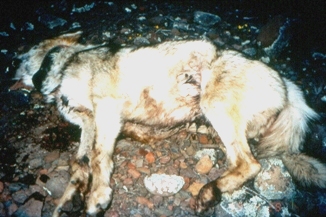New in the Press: Feds investigate latest Mexican wolf death
By SUSAN MONTOYA BRYAN Associated Press
 ALBUQUERQUE, N.M.—Federal law enforcement officials confirmed Friday they are investigating the shooting death of a Mexican gray wolf in southwestern New Mexico, the latest in a series of suspicious deaths that have hampered efforts to return the endangered animal to the Southwest.
ALBUQUERQUE, N.M.—Federal law enforcement officials confirmed Friday they are investigating the shooting death of a Mexican gray wolf in southwestern New Mexico, the latest in a series of suspicious deaths that have hampered efforts to return the endangered animal to the Southwest.
The U.S. Fish and Wildlife Service said the female wolf, identified as F521, was found dead Dec. 2 in Catron County.
Investigators have identified the people believed to be involved, but Assistant Special Agent in Charge Jill Birchell declined to release any names. She said the investigation is ongoing and the wolf’s carcass will undergo a necropsy.
“¦ So far this year, there have been six wolf deaths. All but one have involved suspicious circumstances.
The troubled effort to reintroduce the Mexican gray wolf—a subspecies of the gray wolf—began along the Arizona-New Mexico border in 1998. Biologists had predicted a self-sustaining wild population of 100 wolves by 2006, but the latest count released early this year found 42 between the two states.
The reintroduction program has been hampered by illegal shootings, complaints from ranchers who are concerned about the safety of their families, pets and livestock and the concerns of conservationists who have gone to court numerous times over the past decade to get the agency to revamp its management of the program.
News of the latest death follows an announcement Thursday by the agency that it plans to release a male Mexican gray wolf in southeastern Arizona next month as part of an effort to develop a breeding pair for the Hawks Nest pack.
Officials also announced their intentions of moving ahead with a revised recovery plan, putting more wolves on the ground next year and continuing work on an interdiction fund to help ranchers with livestock depredations.
 Michael Robinson of the Center for Biological Diversity, one of the groups that has been critical of the agency’s management of the program, said Friday the agency has made similar promises in the past.
Michael Robinson of the Center for Biological Diversity, one of the groups that has been critical of the agency’s management of the program, said Friday the agency has made similar promises in the past.
“We have heard repeatedly that things are going to change,” he said. “The fact that they’re releasing one wolf is heartening, but we want to see all of them released and we want to see a robust program of getting wolves into the wild.”
Robinson was referring to an estimated 22 wolves in captivity that have potential to be released into the wild. He said the wolves have been identified as genetically suitable and they are the right age for reproduction.
The Center for Biological Diversity and other groups also continue to push for the federal government to not loan to landowners and others in the area radio telemetry receivers that allow them to track collared wolves. While the receivers are meant for preventing livestock depredation and nuisance incidents, critics say they make the wolves vulnerable to poaching.
Robinson said a request to get more information from the government about the receivers through the Freedom of Information Act has gone unanswered.
“It appears that the Fish and Wildlife Service is hunkered down … and not responding to grave concerns,” he said.
The full article was published in the Las Cruces Sun-News and the Santa Fe New Mexican on December 10, 2010.
Please submit a letter to the editor supporting more wolf releases and stronger protections for Mexican wolves in the wild: Las Cruces Sun-News: letters@lcsun-news.com, Santa Fe New Mexican: http://www.santafenewmexican.com/SendLetter/
Letters to the editor are widely read and are seen by decision-makers as an indicator of public opinion.
Click here to stop wolf extermination legislation in Congress that would strip away protections for endangered mexican wolves!



